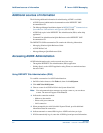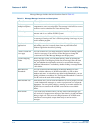
Features of AUDIX 4 INTUITY AUDIX Messaging
Overview
555-233-001 — Issue 2 — November 2000
4-
8
TCP/IP
AUDIX Transmission Control Program/Internet Protocol (TCP/IP) provides the
ability to exchange messages with subscribers on other AUDIX systems. The remote
system can be next to or geographically distant from the local DEFINITY ONE
system.
AUDIX TCP/IP uses the proprietary AUDIX digital protocol to exchange messages,
user profiles, and message-status information with other machines. The digital
protocol uses a digital file format, similar to a data-file transfer between two
computer systems, to transmit the information. Digitally transmitted messages are
communicated quickly and with excellent sound quality.
TCP/IP allows you to exchange voice, fax, text messages, and attached files from
other AUDIX systems. This enables a user to:
• Address messages by name only, known as name addressing. This function
applies only to administered remote recipients. Administered refers to remote
users who have been entered in the database of the local application.
• Include the names and telephone numbers of remote recipients in personal
mailing lists. Nonadministered remote recipients can be included only by
telephone number.
• Hear the spoken name of the intended recipient. If the administrator has not
recorded these names, the user hears only the remote mailbox ID.
• Access the names and number directory ( ) to look up telephone
numbers by name.
• Assign aliases to remote recipients on systems administered for AUDIX TCP/IP.
Administered remote recipients can be included by name or by telephone number.
Nonadministered remote recipients can be included by telephone number only.
• Use automatic addressing to respond to incoming messages.
Nondeliverable Messages defined as “nondeliverable” can be rescheduled for delivery with a
new address, or altered to allow forwarding, if needed.
Delivered Message headers that identify messages delivered but not yet listened to or that
identify messages containing nondeliverable components. The latter type of
message header is an Incomplete Delivery header. For example, if a message
contains more than the four components allowable (that is, a voice, fax, text,
and file attachment), the additional components are not delivered, and the
message header indicates that a component was not delivered.
Accessed Message headers that identify messages that have been listened to. A message
is considered accessed even if only the header has been listened to.
Table 4-2. Outgoing mailbox categories
Category Description
2 of 2
* *
N


















